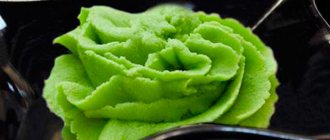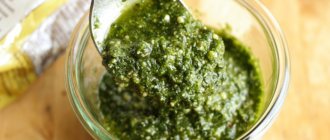Publication in the group: Sauces
Japanese dishes are very popular, so numerous non-traditional recipes and variations have appeared. The most common among them are baked rolls, which are usually served hot or warm. Due to this feature, a variety of sauces are added to them, both in the Japanese style and all kinds of fusion.
General principles for preparing sauce for rolls
Soy sauce is the main ingredient needed to serve and eat sushi and enhances the delicate flavor of fish and seafood. It is made by soaking soybeans in water, roasting and grinding wheat, mixing the 2 ingredients with salt and allowing it to form a dark, aromatic liquid.
Nowadays, there are 3 types of this product that are used in Japanese cuisine:
- Light - has a reddish-brown color and is used for dressings, sauces and marinating ingredients.
- Dark - Has a caramel color with a thicker texture that can color other ingredients, and has a slightly sweeter flavor.
- Thick (cooked with a higher concentration of wheat) - has a thicker and almost viscous texture, as well as a sweet taste. It is often used as a dipping sauce.
According to Japanese etiquette, each sushi roll has the perfect balance of flavors. Therefore, in authentic versions of the dish it is not recommended to use any sauces other than soy. However, bolder versions of the rolls may use teriyaki, unagi or ponzu (they are often drizzled over the filling).
And many fusion recipes even suggest implementing bold ideas - for example, adding sauces to a dish from ingredients that are not typical of the Japanese culinary tradition, and even baking sushi with them.
| Sauce name | Main components | Origin and original use |
| Spicy | Mayonnaise with Sriracha sauce or chili paste and other additives. | Invented in sushi restaurants outside of Japan and often used in the CIS, Europe and North America to add to standard, fried and baked sushi and rolls. |
| Unagi | Soy sauce with mirin and sugar or honey. | The Japanese sauce, traditionally used for frying and baking eel, is now popular in rolls with this product. |
| Creamy garlic | Mayonnaise, rice vinegar, ginger and garlic. | This is a fusion invented in American sushi bars for mixing and pouring fillings on rolls and spreading throughout the world. |
| Ponzu | Soy sauce and citrus juice | Japanese sauce for salad dressing. |
| Tonkatsu | Soy sauce, ginger, mirin and various seasonings. | A Japanese marinade sauce that outside of Japan is used for dipping rolls and soaking the filling. |
| Walnut | Soy sauce and peanut butter | Asian sauce for salad dressing. |
| Goma Dare | Sesame oil, miso paste and various seasonings | Asian marinade sauce and salad dressing (mixed with Ponzu). |
Ingredients for homemade rolls
First of all, you need to prepare the ingredients for the rolls. The set may vary slightly depending on the selected recipe. Instead of fish, seafood is sometimes used, for example, shrimp or crab. Sometimes the composition includes cheeses, sesame seeds, as well as various sauces.
Mandatory set
There is a mandatory set of products for rolls, these are:
- rice;
- rice vinegar;
- nori;
- pickled ginger;
- wasabi;
- soy sauce.
The only exceptions are sweet rolls, which are prepared without hot sauces or ginger.
It's worth starting with choosing rice. Ideally, you need to buy a special variety, the packaging of which indicates that it is intended for sushi and rolls. If such grains are not available, you can purchase any short-grain rice.
Advice! Cereals with long grains and steamed are not suitable.
Rice vinegar is an important ingredient. It differs from the usual one in its softer, slightly sweet taste. If rice vinegar is not available, you can use apple or wine vinegar. These products are diluted half and half with water and a little sugar is added.
Wasabi can be purchased ready-made or in powder form. The latter option is even preferable, since it does not contain preservatives. Powdered wasabi should be mixed with water and allowed to stand for 5-10 minutes.
Nori for making rolls must be selected in the form of whole sheets. Seaweed cut into thin strips will not work.
Pickled ginger is used to season the dish. You can find white and pink ginger on sale, the latter being more spicy.
Soy sauce is served on the rolls as a seasoning. It is advisable to choose a natural product without flavors or dyes.
Which cheese to choose
Cheese is not a mandatory ingredient, but is often included in the roll recipe. Hard varieties are not suitable; you must choose cream cheese with a soft consistency. Most often, Philadelphia cheese is used. You can also use ricotta cheese, mascarpone, feta. As a last resort, you can use soft processed or curd cheese.
Is it possible to do without nori?
Nori can now be bought in supermarkets. But it happens that you don’t have seaweed on hand or you just don’t like it. You can do without nori, but these will no longer be traditional rolls, but an improvisation on the theme of this dish.
Sometimes soy "paper" is used as a substitute for nori. Especially often, so-called inside-out rolls are prepared without nori, in which the top layer is rice.
Creamy garlic sauce
The sauce for baked rolls, the recipe for which is a fusion, has a subtle garlic and ginger aroma and a creamy sweet and sour taste.
It goes well with rice and any seafood.
What ingredients will you need?
- 1 tbsp. mayonnaise;
- 4 tbsp. l. white sugar;
- 1 tbsp. l. rice wine vinegar;
- 2 tbsp. l. softened unsalted butter;
- 1 tsp. paprika;
- 0.75 tsp. garlic powder;
- 0.5 tsp. ginger powder.
Step-by-step cooking process
- In a small bowl, combine mayonnaise, white sugar, rice vinegar, softened butter, paprika, ginger and garlic powder.
- All ingredients must be mixed well, covered and refrigerated for 2-3 hours.
Historical reference
The history of sushi began in the rice fields of Asia, where fish was “canned” with rice vinegar, salt and rice, after which the rice was removed and the fish was served. Today, fish preserved in this way is known as “narezushi”, and this dish originated in the Yayoi period. During the Muromachi period, the Japanese began mixing rice and fish into a single dish, and during the Edo period they began using vinegar rather than pickled rice. Nowadays, lumpy rice soaked in vinegar and topped with pieces of fish is known as sushi.
In modern Japanese cuisine, there are many varieties of dishes prepared with rice, vinegar and nori sheets: rolls, maki, gunkan, etc. The taste of a dish depends not only on the ingredients included in it, but also on the sauce with which these dishes are served, and which is added to sushi as one of the components.
We offer several interesting recipes that will not leave even the most devoted fans of Japanese cuisine indifferent.
Cheese sauce
The sauce for baked rolls, the recipe for which contains cheese, was originally not related to Japanese cuisine. Nowadays it is often used in combination with shrimp and mussels.
What ingredients will you need?
- 6 tbsp. l. mayonnaise;
- 2 tbsp. l. finely grated parmesan;
- 0.5 tsp. lime juice;
- 0.5 tsp. pepper hot sauce (such as Sriracha);
- 1 tsp. white sugar;
- 1 tbsp. l. tobiko caviar.
Step-by-step cooking process
- In a small container you need to combine all the ingredients for the sauce.
- You need to mix everything well, taste and adjust the spiciness and sweetness.
- If desired, you can not add tobiko caviar right away, but place it on the surface of the baked sauce.
Benefits and harms of the product
The classic version contains vitamins A, B, C, d, E, K, PP and minerals - iron, magnesium, calcium, potassium, phosphorus and others.
Tobiko caviar enriches the body with proteins and amino acids.
Garlic and onions are enriched with phytoncides, which can help prevent infections and seasonal colds.
Spicy seasoning can boost immunity in winter and improve the functioning of the gastrointestinal tract.
Not everyone can eat hot sauce; if you have the following pathologies, it is best to avoid eating hot sauce:
For diseases of the cardiovascular system.
For diseases of the gastrointestinal tract (for example, pancreatitis, gastritis, ulcers of various locations, cholecystitis).
With excess body weight.
If you have diabetes.
Since the sauce contains a lot of fat, pungency, and is highly colorful, this can cause a deterioration in the condition during exacerbation of chronic diseases. Consumption in large quantities may lead to weight gain. It is not recommended to include dressing in the menu of elderly people, pregnant and lactating women.
Soy sauce Nikiri
Nikiri soy sauce may not be the most popular for sushi and rolls. Although it is made from soybeans, it is distinguished by its light amber color and distinct sweet taste. The sauce is quite thin, so it is usually poured over ready-made baked rolls or used for dipping.
What ingredients will you need?
- 1 tbsp. quality soy sauce;
- 1 tbsp. Mirina;
- 0.5 tbsp. homemade dashi (fish broth made from dried tuna);
- 1.5 tbsp. l. sake.
Step-by-step cooking process
- You need to take a small saucepan and place it on the stove, set the heat to minimum, pour in all the ingredients and heat slowly.
- Then you need to let the mixture boil and cook until most of the liquid has evaporated (this should take about 15-20 minutes).
When the sauce reaches the consistency of syrup, it's ready. It should be cooled and used in recipes.
Ready.
How to cook rice for rolls
Properly prepared rice for rolls is half the success. You can cook rice in a regular saucepan or using modern kitchen appliances - a microwave or multicooker.
In a slow cooker
It's very easy to cook rice for rolls in a slow cooker. The cereals need to be washed well and poured into the bowl. Fill with water. For 1 measuring cup of rice you need to take 1.5 measuring cups of water. We do not add salt and spices. We turn on the “rice” mode (in other models this mode may be called “buckwheat”, “cereals”, “porridge”). After completing the mode, turn off the multicooker, but do not open the lid for another 5-10 minutes.
In a saucepan
You can cook rice in a saucepan on the stove. Wash the rice well, changing the water at least 6-7 times. Place the washed rice in a large saucepan and add water. There should be one and a half times more water than rice. That is, if you took a glass of rice, then you need to take 1.5 glasses of water. No need to add salt.
For flavor, you can add a small piece of kombu seaweed to the pot with the rice. But the algae must be removed before the water boils.
As the water boils, reduce the heat to low and cover the pan with a lid. Cook for 10-15 minutes. All water should be completely absorbed into the grains. Don't overcook! There is no need to stir the rice during cooking.
Tonkatsu sauce
The sauce for baked rolls, the recipe for which was originally used in Japan as a marinade for fish and meat, has a thick consistency and a sweet taste. It enhances the aroma and texture of any product, therefore, with some changes in composition, it is added to various fillings and as a decoration for the finished dish (for drizzling and basting).
What ingredients will you need?
- 0.5 tbsp. ketchup;
- 1.5 tsp. Worcestershire sauce;
- 1 tbsp. l. brown sugar;
- 2 tbsp. l. soy sauce;
- 1 tbsp. l. mirin (Japanese sweet wine);
- 1 tsp. grated fresh ginger;
- small clove of garlic, grated.
Step-by-step cooking process
- Place all ingredients in a medium-sized container and mix thoroughly until a homogeneous mixture is obtained.
- Next you need to leave it for 30 minutes. under a lid or film so that the flavors combine well.
- Traditional Japanese tonkatsu sauce is prepared with the addition of finely chopped pulp of fresh fruits or vegetables, or puree from them. If desired, you can put in it any suitable component of this category (tomato, celery, plums, apples, dates, leeks, carrots, citrus fruits).
Tonkatsu sauce for baked rolls, recipe.
Ready.
Recipe No. 3. Dynamite Roll
To prepare rolls with such a threatening name, you need to take tempura flour, fresh cucumber, shrimp, Japanese mayonnaise, Kimchi paste, nori and rice.
The sauce is again made from mayonnaise and Kimchi, although you can use any spice sauce recipe. Next you need to prepare the tempura dough, it is very simple. You need to sift 1 cup of tempura flour, pour 1 egg into 1 cup of ice water, mix thoroughly, and quickly knead the dough, gradually pouring water and egg into it. Vegetable oil is poured into a saucepan or deep frying pan. The shrimp are first dredged in flour, then dipped in dough and then in oil. When a golden crust appears, the shrimp can be removed from the oil. The rolls will be filled with shrimp in batter and cucumber. Otherwise they are prepared the same way.
Peanut sauce
This is a sauce of Asian origin that is traditionally used to season seaweed salads. It is great for filling rolls, and when baked, it imbues the filling with its creamy texture and peanut aroma.
What ingredients will you need?
- 1 tbsp. l. hoisin sauce;
- 0.75 tbsp. peanut butter;
- 0.25 tbsp. soy sauce;
- water;
- chopped peanuts.
Step-by-step cooking process
- In a small bowl, place hoisin sauce, peanut butter, soy sauce and 0.5 tsp. water (more may be needed depending on the thickness of the peanut butter you use).
- Everything needs to be whipped with a whisk or immersion blender until smooth.
- It is recommended to sprinkle the prepared rolls with nut sauce with chopped peanuts.
Ready.
With masago caviar
The sauce for baked rolls, the recipe for which suggests using kyupie (Asian) mayonnaise and pickled masago caviar, is very widespread. It has a noticeable pungency with a creamy consistency, and is often used in soft seafood fillings (shrimp, crab).
What ingredients will you need?
- 0.5 tbsp. cupie mayonnaise;
- 1-2 tbsp. l. hot chili sauce (Sambal Oelek or Sriracha);
- 1 tbsp. l. masago caviar.
Step-by-step cooking process
- All components should be placed in a small container and mixed well.
- Next, the sauce should be left covered in the refrigerator for 2-3 hours.
Spicy
Creamy spicy sauce is used in sushi and rolls, including baked and fried tempura. It goes well with all types of fish, seafood, vegetables and seaweed.
What ingredients will you need?
- 0.25 tbsp. Asian mayonnaise (kyupie);
- 4 tsp. Sriracha sauce;
- 1-2 drops of sesame oil;
- 1-2 drops of honey (optional).
Step-by-step cooking process
- You need to beat 0.25 tbsp. Asian mayonnaise (can be replaced with regular table mayonnaise or plain Greek yogurt) and 4 tsp. Sriracha sauce until completely combined.
- Next, you need to taste the mixture and add more Sriracha if you want a spicier sauce, and also add a little toasted sesame oil and, if desired, honey, stir well.
- The prepared spicy sauce can be used to soak the filling of the rolls, as well as pour over the finished products.
Pickled ginger
Gari, or pickled ginger, is a traditional addition to sushi along with wasabi. It has a specific pungent taste. Ginger is eaten between different types of sushi so that their flavors do not mix in the mouth. The technique for preparing the seasoning is quite simple: thin ginger slices are marinated with vinegar and sugar. Vinegar turns fresh white ginger a soft pink even without the use of artificial colors. On last year's ginger, a strong effect from the action of vinegar is not visible.
Wasabi, or Japanese horseradish, is another constant companion of sushi and rolls. In fact, the plant from which wasabi is produced, Eutrema japonica, is not horseradish, although it belongs to the same family. In some languages the condiment is called "mustard greens".
Wasabi is used in almost all Japanese dishes. When eaten with sushi, the paste is spread in a thin strip on rice or mixed with soy sauce, thus adjusting the level of spiciness.
As the name implies, a characteristic feature of this seasoning is its spiciness (from the English spicy - spicy, spicy). There is no universal recipe; in each region, spicy sushi is prepared differently. Most often, in its composition you will find Japanese kyupie mayonnaise, hot chili peppers, kimchi paste, soy sauce, vinegar and flying fish caviar. Recipes may also include vegetables and seasonings: onions, garlic, tomatoes, etc.
Spicy is especially good in combination with hot or baked rolls, but for spicy lovers, we can recommend trying it with traditional sushi. Spicy is also suitable as a salad dressing, as an addition to meat and fish.
Ponzu
Ponzu has a bright citrus aroma, which can be an excellent addition to seafood to highlight its taste. An Asian dressing based on soy sauce with a sour-spicy taste has recently become widespread in the preparation of sushi.
It is used both as a dipping sauce for hot rolls and/or as a marinade for seafood fillings to enhance their flavor.
What ingredients will you need?
- 0.5 tbsp. light soy sauce;
- 0.25 tbsp. fresh lemon or orange juice;
- 1 tbsp. l. mirin or rice wine;
- 1 tbsp. l. water;
- 1/8 tsp. red pepper (chopped).
Step-by-step cooking process
- All components must be combined in a deep container and mixed evenly.
- Then you need to cover the dishes with a lid or film and leave to stand at room temperature for 30-60 minutes.
- After this, transfer the sauce into a clean jar and place in the refrigerator until use.
Teriyaki
This sauce is the most famous Japanese marinade, which is very popular internationally. In Japan, it is used to marinate fish, meat and chicken before frying, but its use in sushi and rolls has also proven successful. Since the sauce is quite liquid, it can be poured over the finished dish or served for dipping.
What ingredients will you need?
- 1 tbsp. water;
- 0.25 tbsp. soy sauce;
- 5 tsp. brown sugar;
- 1 tbsp. l. honey (or more to taste);
- 0.5 tsp. ground ginger;
- 0.25 tsp garlic powder;
- 2 tbsp. l. corn starch.
Step-by-step cooking process
- Place a small saucepan on the stove, set the heat to medium and combine all the teriyaki ingredients except the cornstarch and cold water.
- The above ingredients should be placed in a separate bowl and whisked until completely combined.
- Then you need to pour the resulting suspension into a saucepan, stir, boil the sauce and cook until the desired consistency is achieved.
- If the teriyaki becomes too thick, you can add a little water.
As soon as the desired thickness is achieved, you need to turn off the stove, pour the sauce into a glass bottle and put it in the refrigerator.
Cooking with yeast
To get a fragrant Japanese delicacy, just use yeast. We will tell you below how to prepare sushizu with them.
- egg white – 2 pieces;
- granulated sugar – 110 grams;
- dry yeast - 2 packets;
- water - 150 milliliters.
Cooking time: 20 minutes.
Calorie content per 100 grams: 175 kcal.
- Dissolve the yeast in the water and leave for five minutes. Add the protein, mix everything and put it on the stove.
- Pour granulated sugar into the pan and stir every two minutes. The sugar should dissolve.
- Cook the mixture without ceasing to stir. When it acquires a gray color and thickness, remove from the oven and cool.
- Use the cooled mixture for rice or put it in the refrigerator.
Unagi
The unagi recipe is quite easy - it consists of a mixture of soy sauce, mirin and sugar in equal proportions. Despite the name, it does not contain eel meat and is vegan. This is probably one of the most popular sauces used in classic and baked rolls. Its consistency is thick and sticky, its color is rich dark. The sauce tastes sweet, with high umami content.
Its name is associated with the peculiarities of its use in Japan. It is used mainly for eel - fried, smoked or baked, as well as various dishes made from it. Sushi and eel rolls are also traditionally seasoned and topped with unagi. But outside of Japan, a variety of rolls are prepared with this sauce, with any fillings and their combinations.
What ingredients will you need?
- 0.5 tbsp. soy sauce (gluten-free variety if necessary);
- 0.5 tbsp. granulated sugar;
- 0.5 tbsp. sweet Japanese wine mirin.
Step-by-step cooking process
- You need to combine all 3 ingredients in a small saucepan and stir well.
- The mixture must be boiled over high heat, the heat reduced to minimum and simmer until its volume is reduced to approximately 0.75 tbsp. (if you continue cooking further, you will get caramel, not sauce).
- Then you need to turn off the stove and cool the unagi to room temperature.
- Once cooled, pour the sauce into a tightly sealed container, refrigerate, and keep chilled until ready to use. It is perfect for rolls with a strong or complex taste.
- The sauce can also be used to decorate the finished dish. To do this, you need to put the unagi in a ziplock bag or a plastic bottle. In the first case, you will need to cut off the tip of the bag, in the second, make a hole in the lid.
- This will allow you to spread the sauce in beautiful lines and patterns across the surface of the rolls and on the plate.
How to properly wrap and cut rolls
It is very important to wrap and cut the rolls correctly. If you do this work incorrectly, the rolls will fall apart or simply look ugly. Of course, you may not get the perfect shape the first time. But with a little practice, you will get beautiful, even rolls.
With bamboo mat
The easiest way is to prepare rolls with a bamboo mat. This is a special flexible mat with which you can give the rolls their shape.
We position the rug so that it is convenient to roll it away from you. Place a sheet of nori on the mat, with the rough side facing up. The edges of the nori sheet should match the edges of the mat.
We wet our hands with water, take a handful of seasoned rice and roll it into a ball. Place the rice ball in the center of the nori sheet. Now carefully distribute the rice. The layer of rice should cover the nori sheet completely, departing 2 cm from the edges. Then lay out the prepared filling. For example, strips of salmon and cucumber.
Now we begin to roll our roll, lifting the edge of the mat closest to us. Use your thumbs to roll up the mat and gently hold the filling with your other fingers. We continue to twist, carefully bending the edge of the mat so that it does not get inside our product. You need to roll it tightly. When the roll is wrapped, you need to gently squeeze the prepared product with your hands over the mat to make the roll tight.
Then remove the mat and cut into portions with a sharp knife. The cut pieces should be uniform, so novice cooks are advised to mark the cut lines first and then cut. Moreover, it is important not to press with a knife so as not to crush the roll. You need to cut using a sawing motion.
Without mat
If you don’t have a mat, you can make a similar one yourself. To do this, prepare two pieces of foil, put them together, and tuck the edges. For rigidity, you can insert wooden sticks into the edges of our improvised rug. All that remains is to cover our improvised mat with cling film and you can make rolls, as when using a bamboo mat.
Rolls inside out
You can prepare rolls “inside out”; they differ from regular ones in that they have rice on the top layer.
To prepare, you need to prepare a mat and wrap it in cling film. Then lay a thick layer of rice on top of the film (layer thickness 3-4 mm). The size of the rice layer should be equal to half a sheet of nori.
Then place half a sheet of nori on the rice, placing it with the rough side down. We move the seaweed sheet towards ourselves a little. Spread the cream cheese over the nori and add the filling. Roll the roll using a mat.
We wrap the mat with our thumbs and hold the filling with the rest. Squeeze the finished roll a little to make it denser. Then remove the mat, and roll the finished roll in sesame seeds (or another type of breading). Cut the roll into portions.
Mango flavored
Mango sauce is sweet and sour and ideal for many types of sushi and rolls. It goes especially well with tuna and avocado.
What ingredients will you need?
- 0.3 tbsp. rice vinegar;
- 0.3 tbsp. granulated sugar;
- 0.5 tsp. salt;
- 1 large ripe mango;
- 2 tbsp. l. vegetable oil.
Step-by-step cooking process
- In a small saucepan, combine the vinegar, sugar and salt, boil over moderate heat, whisking constantly until the sugar dissolves, then turn off the stove and cool to room temperature.
- The mango should be peeled, the pit removed, and the pulp cut into pieces.
- Transfer to a blender along with the cooled vinegar-sugar mixture and vegetable oil, beat until a completely homogeneous and smooth puree is obtained.
- The finished sauce should be poured into a serving container, covered and refrigerated until use.
- Before serving, it is recommended to place it in a zip bag or container with a dispenser and apply it to the surface of the rolls and serving plate in the form of patterns or complex lines.
Korean with apple juice
This sauce belongs to Korean cuisine, but it can be successfully used in Japanese rolls. It adds a pleasant spiciness and sourness to the dish.
What ingredients will you need?
- 6 tbsp. l. (102 g) fermented chili paste (gochujang);
- 2 tbsp. l. (26 g) granulated sugar;
- 1.25 tsp. (6 ml) soy sauce;
- 1.25 tsp. (6 ml) sake;
- 1.5 tbsp. l. (7 ml) sesame oil;
- 2.5 tsp. (8 g) minced garlic;
- 2 tbsp. l. (30 ml) fresh apple juice;
- 2.25 tsp. (6 g) sesame seeds.
Step-by-step cooking process
- It is necessary to heat a frying pan (dry) over low heat, add 2.25 tsp. sesame seeds and cook them for 3-4 minutes. During this time, they will darken and become crispy, and will also begin to emit a noticeable nutty aroma. They should be transferred to a plate and cooled.
- Then you need to place all the components in one container and stir very well with a spoon or whisk. The sugar should completely dissolve.
- The finished sauce should be thick and creamy.
Dressing for sushi rice with regular vinegar
Simple vinegar makes any soaking of rice grains unique. We'll tell you how to do it further.
- table vinegar 5% - 50 milliliters;
- soy sauce – 50 milliliters;
- sugar – 20 grams.
Cooking time: 15 minutes.
Calorie content per 100 grams: 168 kcal.
- We will prepare all the products in advance. Let's take a pan and place them there.
- Place the dishes on the fire and cook until the vinegar boils and the sugar dissolves.
- As soon as the granulated sugar crystals dissolve, remove the rice sauce from the heat and leave to cool for a while.
- While it cools, cook the rice cereal and make the filling. We will definitely use the cooled mixture to prepare a delicious Japanese dish.
Goma Dare
This is another classic Asian sauce that has recently begun to be used for sushi and rolls.
In Japan, it is common as a salad dressing and marinade for vegetables and seaweed.
What ingredients will you need?
- 3 tbsp. l. sake;
- 2 tbsp. l. nerigoma (tahini sauce);
- 1 tbsp. l. ponzu sauce;
- 1 tbsp. l. miso paste;
- 0.5 tbsp. l. vegetable oil with a neutral taste (rapeseed, sunflower, etc.);
- 0.5 tbsp. l. sesame oil (fried);
- 1 tsp. sugar sand;
- 1 tsp. Mirina;
- 1 tsp. rice vinegar;
- garlic (grated, optional).
Step-by-step cooking process
- All ingredients must be placed in a deep bowl and whisked until completely homogeneous.
- Ready Goma Dare should be transferred to an airtight container and stored in the refrigerator for up to 7-10 days.
Japanese white sauce
Spicy, creamy and thick, this sauce is served with meat dishes in Japanese cuisine. However, it is also well suited for fish, seafood, vegetables and rice, so it is often added to rolls (including hot ones).
What ingredients will you need?
- 2 tbsp. Asian mayonnaise (kyupie);
- 0.5 tbsp. ketchup;
- 3 tbsp. l. Sahara;
- 1 tbsp. l. garlic powder;
- 1 tbsp. l. paprika;
- 1 tsp. onion powder;
- 1 tsp. salt;
- 0.5 tsp. cayenne pepper;
- 0.5 tbsp. water;
- 1 tsp. Sriracha or other hot sauce.
Step-by-step cooking process
- You need to place all the ingredients in a large kitchen bowl.
- Next, you need to quickly whisk everything with a whisk until the sauce becomes completely homogeneous, without any lumps or crystals. This will take about 2 minutes.
- Refrigerate the prepared sauce in a covered container or bowl with a lid (or plastic wrap over the top) until use.
Types of sauces for sushi - choosing spicy additions to Japanese dishes
Traditional Japanese food - sushi - has become one of the most popular dishes often ordered in restaurants, and fast sushi delivery in Minsk makes it possible to enjoy your favorite types of rolls and sushi in the comfort of your home. It should be noted that in Japanese cuisine, great importance is attached to sauces and pickled vegetables, which are a bright addition, an important component of dishes, emphasizing and revealing their individuality. Some give them piquancy, a slight spiciness, favorably emphasizing the taste and aroma of food, while others fill traditional dishes with a sweetish-spicy note. Our article is about what types of sauces are served for sushi.
Content:
Useful tips and tricks
Of all the popular sauces for rolls, unagi has the most specific taste and aroma. It can be used with any fillings, but it is not recommended to mix it with fish with mild flavors, since it will be practically undetectable in this combination.
Adviсe:
- Many people confuse unagi and oyster sauce. The two products have some similarities, but the texture of unagi is much more liquid. Oyster sauce is thick and in some cases does not contain oysters, only extract. As a rule, it is not used to add to sushi and rolls.
- Many sauces for Japanese dishes are based on soy sauce and/or mirin. Because soy sauce is made with wheat, it is not suitable for people with gluten intolerance. For gluten-free recipes, use tamari instead. It is a by-product of making miso paste and no wheat is added during the fermentation process. Its taste is almost identical to regular soy sauce, so this substitution will practically not change the quality of the dish.
- Mirin is a Japanese sweet wine used for culinary purposes. In sauces, it balances out the sweet components while adding some acidity to the mix. Mirin also contributes slightly to the umami flavor profile, but mostly just enhances the flavor through the acidity. If this wine cannot be found, you can replace it with dry sherry.
- If you want to remove spiciness from the recipe, you should exclude ground peppers from the list of ingredients. If the sauce contains Sriracha, don't skip it. This component is responsible not only for the pungency, but also for the aroma, and without it the best result will not be obtained.
- If you want a sweeter sauce, you can add more sugar. However, it is recommended to add it in small portions (no more than 1 teaspoon at a time), then mix everything, leave to stand for 1-2 minutes, and only then taste to check the sweetness.
It is recommended to store sauces for baked rolls prepared according to most recipes in the refrigerator until use. This not only keeps them fresh, but also allows for the best blending of aromas and flavors.











